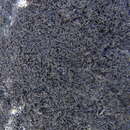en
names in breadcrumbs


Pseudephebe pubescens, also known as 'fine rock wool', is a temperate alpine lichen.[1][2][3] It is a member of the genus Pseudephebe,[4] a lichen group characterized by dense mats of brown to near-black "hairs".[1]
Pseudephebe pubescens was first described in 1930 by Maurice Choisy. Linnaeus had previously described it as Lichen pubescens in 1753.[4] It is usually distinguished from P. minuscula due to P. pubescens preferring a moister habitat and its branches are more terete and lack the irregularities of P. minuscula.[5] The morphological and ecological differences between the two species are often overlapping, and it can be difficult to truly distinguish the two without molecular analysis.[6][7]
P. pubescens is a fruticose lichen that forms decumbent mats made of isotomic-dichotomous branching thalli. The branching occurs frequently and weaves around itself, leading to the woolen appearance. Dark brown to black in color and shiny.[8] Apothecia are rare, but are rarely greater than 6 mm in diameter and have the same appearance as the rest of the thallus.[9] The species lacks isidia, soredia, and pseudocyphellae.[6] Pycnidia occur in great numbers on tubercles with conspicuous ostioles. It is not known to produce any secondary metabolites.[10]
Pseudephebe pubescens is found specifically on acidic or silicate rocks in temperate-alpine or sub-arctic regions.[1] It has circumpolar sightings, being found from the Canadian territories, throughout the United States, and sometimes in alpine Mexico.[1] It has been known in Europe, but recently discovered in China[7] and even been found in the Andes and in Australia.[11] It has been known to grow upon wood occasionally. Pseudephebe pubescens tends to be in more temperate environments than P. minuscula.
Pseudephebe pubescens, also known as 'fine rock wool', is a temperate alpine lichen. It is a member of the genus Pseudephebe, a lichen group characterized by dense mats of brown to near-black "hairs".